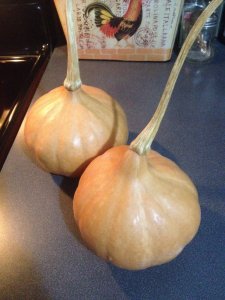- Thread starter
- #11
digitS'
Garden Master
A number of outfits now sell for that Tetsukabuto Squash.
A hybrid of C. moschata and C. maxima. Outrageous! I wonder if the seeds of those Tetsukabuto are viable. Johnny's says that it "Can also be used as a rootstock for enhancing vigor and soil disease resistance in melon, watermelon, and cucumber." What!!??
I'm now dependant on Johnny's for the Cha Cha, f1. I probably need to save and plant 100 seeds of their Buttercup neighbors to see if I can get a useful cross like @flowerbug 's.
Steve
A hybrid of C. moschata and C. maxima. Outrageous! I wonder if the seeds of those Tetsukabuto are viable. Johnny's says that it "Can also be used as a rootstock for enhancing vigor and soil disease resistance in melon, watermelon, and cucumber." What!!??
I'm now dependant on Johnny's for the Cha Cha, f1. I probably need to save and plant 100 seeds of their Buttercup neighbors to see if I can get a useful cross like @flowerbug 's.
Steve

